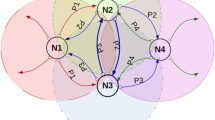Abstract
Channel rendezvous is an important part of broadcast algorithms in cognitive radio ad hoc networks (CRAHNs). To ensure broadcast and network performance when the node energy is limited, an active rendezvous broadcast algorithm based on channel weight in CRAHN is proposed. From the perspective of balanced utilization of high-quality channels, the proposed algorithm uses the one-to-many pairing method of nodes. And channel utilization and effective channel capacity are used to calculated channel weight. A channel weights calculation formula based on available channel set, channel usage counter and channel signal-to-noise ratio is proposed. In each time slot, the best channel is selected according to the channel weight and used as the rendezvous channel for broadcasting to realize active switching between channels. And there is no need to exchange any control information between adjacent nodes. Simulation results show that, compared with the compared algorithms, the proposed algorithm achieves the balanced use of high-quality channels, improves the average channel capacity and broadcast coverage, enhances the network lifetime, and reduces the broadcast delay.















Similar content being viewed by others
REFERENCES
Yao, Y., Research on anti-jamming MAC technology in wireless Ad Hoc network, Chengdu: Univ. Electronic Science and Technology, 2019.
Ge, Z.G., Research on clustering and channel hopping sequence design algorithm in cognitive wireless networks, Xi’an, Chang’an: Xidian Univ., 2018.
Wang, Y.-T., Yang, G.-C., Chang, M.-K., and Kwong, W.C., Contention resolution mechanisms for multi-channel cognitive radio ad hoc networks, IEEE Commun. Mag.,2018, vol. 56, no. 4, pp. 149–155. https://doi.org/10.1109/MCOM.2018.1700705
Hossain, A. and Sarkar, N.I., Cross layer rendezvous in cognitive radio ad-hoc networks, Int. Telecommunication Networks and Applications Conf. (ITNAC), Sydney, 2015, IEEE, 2015, pp. 149–154. https://doi.org/10.1109/ATNAC.2015.7366804
Shen, J.-P., Su, C.-W., and Chang, G.-Y., Asynchronous quorum-based blind rendezvous schemes for cognitive radio networks, IEEE Trans. Commun., 2016. vol. 64, no. 3, pp. 918–930. https://doi.org/10.1109/TCOMM.2015.2508803
Yang, B., Liang, W., Zheng, M., and Liang, Y.-C., Fully distributed channel-hopping algorithms for rendezvous setup in cognitive multiradio networks, IEEE Trans. Veh. Technol., 2016. vol. 65, no. 10, pp. 8629–8643. https://doi.org/10.1109/TVT.2015.2510359
Yang, B., Zheng, M., and Liang, W., A time-efficient rendezvous algorithm with a full rendezvous degree for heterogeneous cognitive radio networks, in IEEE INFOCOM 2016—The 35th Ann. IEEE Int. Conf. on Computer Communications, San Francisco, 2016, IEEE, 2016, pp. 1–9. https://doi.org/10.1109/INFOCOM.2016.7524556
Paul, R. and Choi, Y.-J., Adaptive rendezvous for heterogeneous channel environments in cognitive radio networks, IEEE Trans. Wireless Commun., 2016. vol. 15, no. 11, pp. 7753–7765. https://doi.org/10.1109/TWC.2016.2607170
Sun, W. T., Research and implementation of broadcasting technologies of cognitive radio ad hoc networks, Beijing: Beijing Univ. of Posts and Telecommunications, 2019.
Pu, H., Gu, Z., Lin, X., Hua, Q.-S., and Jin, H., Dynamic rendezvous algorithms for cognitive radio networks, in IEEE Int. Conf. on Communications (ICC), Kuala Lumpur, 2016, IEEE, 2016, pp. 1–6. https://doi.org/10.1109/ICC.2016.7511437
Xin, C.S., Ullah, S., Song, M., Wu, Z., Gu, Q., and Cui, H., Throughput oriented lightweight near-optimal rendezvous algorithm for cognitive radio networks, Comput. Networks, 2018, vol. 137, pp. 49–60. https://doi.org/10.1016/j.comnet.2018.03.009
Zhang, Y.P., Spectrum handoff method by using joint optimization of cumulative delay and channel capacity based on multi-objective PSO, J. Telecommun. Sci., 2018. vol. 34, no. 7, pp. 62–71. https://doi.org/10.11959/j.issn.1000-0801.2018114
Liu, B., Research on the nodes movement strategy for mobile ad hoc networks based on the energy particle algorithm, Chin. J. Sens. Actuators, 2019. vol. 32, no. 8, pp. 1261–1265.
Author information
Authors and Affiliations
Corresponding authors
Ethics declarations
The authors declare no conflict of interest.
About this article
Cite this article
Qiaoqiao Lou, Zhao Zhijin Active Rendezvous Broadcast Algorithm Based on Channel Weight in Cognitive Radio Ad Hoc Networks. Aut. Control Comp. Sci. 55, 431–443 (2021). https://doi.org/10.3103/S0146411621050059
Received:
Revised:
Accepted:
Published:
Issue Date:
DOI: https://doi.org/10.3103/S0146411621050059




